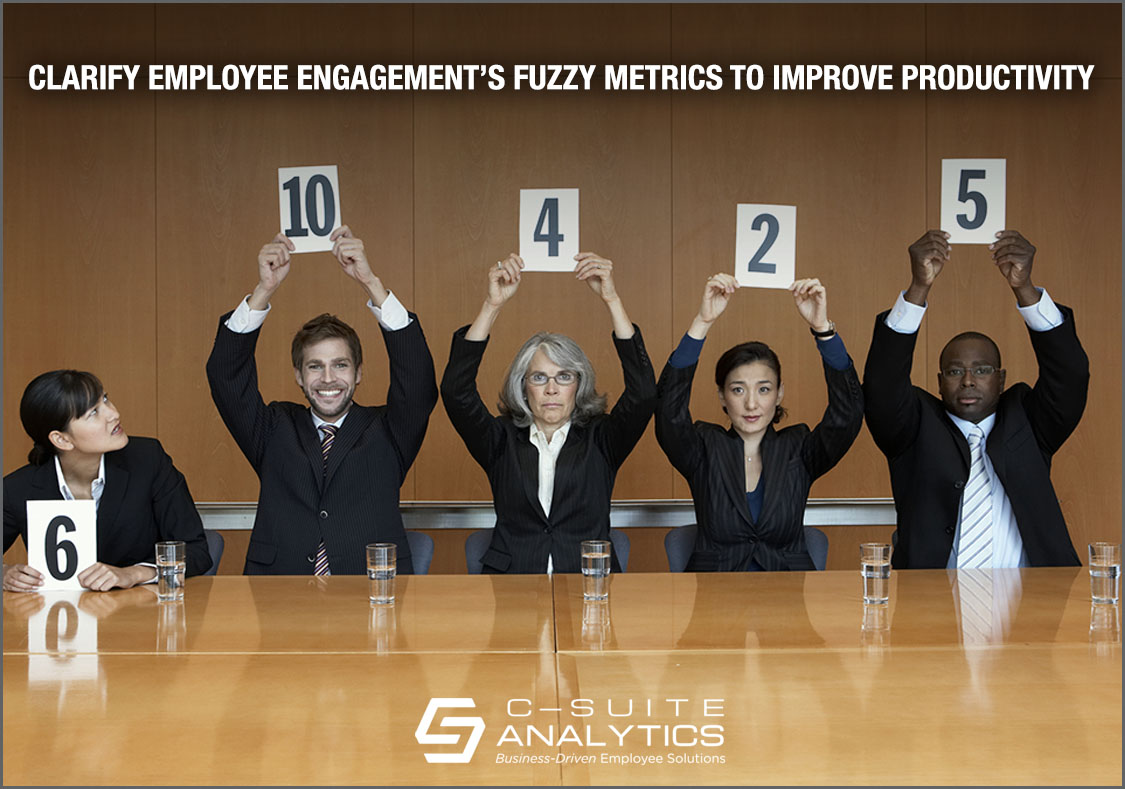Most hiring tools answer whether candidates can and will do the job, but not if they’ll stay. Learn how realistic job previews and motivational-fit interviews can improve retention from day one.
Clarify Employee Engagement’s Fuzzy Metrics to Improve Productivity

Employee engagement is a fuzzy concept that usually generates a fuzzy metric. Most of us conduct employee engagement surveys using a vendor’s survey or our own, and we presume the outcomes from these employee engagement surveys tell us how much our employees are committed to their work. And we also assume those same commitment levels never vary, that a one-time snapshot on the third Thursday in March reflects how our employees feel about their jobs every day.
Employee Engagement or Engagement Scores More Important?
Of course, we do want to know how committed they are…and there are good reasons to try to figure it out. Unknown to most executives, employee engagement directly impacts productivity far more than pay, benefits, and the other tangible aspects of people management that have greater celebrity status. Most conversations about employee engagement, though, are centered on survey scores because scores are tangible.
In 2018 I authored a book titled Raise Your Team’s Employee Engagement Score. Why did I focus the book’s title on scores rather than on engagement? Because most organizations’ and managers’ purposes in pursuing engagement metrics are to get higher scores, higher numbers, with less emphasis on implementing actual strategies that improve productivity.
Why is Employee Engagement Important?
Is employee engagement important? Absolutely…and here is a short list of why employee engagement matters:
- Gallup calls the correlation of engagement to performance as “substantial and highly generalizable across organizations” …and industries…as they compared top-quartile engagement-scoring organizations to bottom-quartile ones…along with correlations to lower turnover plus significant improvements in safety, shrinkage, absenteeism, and quality.[i]
- The MIT Sloan Management Review reported companies with 10 to 15% profit growth had highly engaged employees, whereas those with low or zero profits had employees who were disengaged.[ii]
- Towers Perrin studied 40 global companies finding those with the most engaged employees increased operating income 19% and earnings per share 28% year-to-year…whereas those companies with the lowest percentages showed year-to-year declines of 33% in operating income and 11% in earnings per share.[iii]
These data metrics are the type that make CFOs drool. Each of these studies is really cause-and-effect because employees don’t work harder because their companies are more profitable. The opposite is true. These companies are succeeding on critical business metrics because their people are more engaged. Employee engagement is so much more than just a survey.
For me, these studies remind me of one I read years ago where a 10% increase in retail sales efforts resulted in increased sales of nearly 23%. I think of my local smoothie shop that now sells many healthy food products. When I go, I always buy just a smoothie…partly because no one ever asks me to buy anything else.
Mine Better Data from Employee Engagement Surveys
Engagement matters a lot, measuring it brings complexities, and we would never want to ignore it. If your company conducts a periodic employee survey or more frequent pulse surveys, here are guidelines to get the most out of them:
- Get data for each leader on each level, from the CEO down to first-line leaders. Since the greatest driver for engagement is how much employees trust their immediate supervisors, you must learn how each leader on each level is scored by their teams on engagement.
- Ensure at least one-third of your questions require your employees to rate her direct supervisor on issues such as trust…most important…as well as communicating, recognizing, and coaching. This matters because one-size-fits-all programs for any of these topics are mostly a waste of time. Leaders must build trust, communicate, recognize, and coach on their own.
- Scrap any external benchmarks to other companies for two reasons: Most companies don’t know how to improve engagement so how you compare to them isn’t relevant and placing in the middle of the pack compared to others reduces your top team’s interest in getting better.
- Ask leaders to submit a plan of employee engagement activities to improve their scores, and then review that plan to ensure it is about improving relationships versus having more meetings or more events with food…and then hold them accountable for doing their plan.
- Track leaders’ performance over two or three surveys and recommend they be fired if they cannot get their scores at least as high as other leaders’ scores by showing survey-to-survey improvement. No CEO would tolerate a manager who cannot improve sales or service and engagement impacts both.
What if your company does not conduct a survey? Don’t feel compelled to start one. Instead, ask finance to compare productivity levels for similar departments, knowing your CFO is now attuned to engagement based on the correlations offered above. And pair this data with turnover data because turnover is NOT a fuzzy metric as the employee is either at work or is gone.
Stay Interviews for Employee Engagement
The best solution to engagement and retention is the duo-combo of Stay Interviews + accountability. Tell your managers they have goals for engagement and retention, teach them to conduct Stay Interviews, tell them to find out what their employees need…and then your managers should give your employees what they need as best they can.
Our clients would tell you the only complicated part of this plan is training your leaders to conduct Stay Interviews effectively. A sophisticated blend of skills training with supervised exercises helps leaders with little or no supervisory experience to ask, listen, probe, and ultimately solve each employee’s problems as best possible.
And if you and other executives are reluctant to hold leaders accountable for retention and engagement, re-read the part above about engagement’s impact on productivity.



